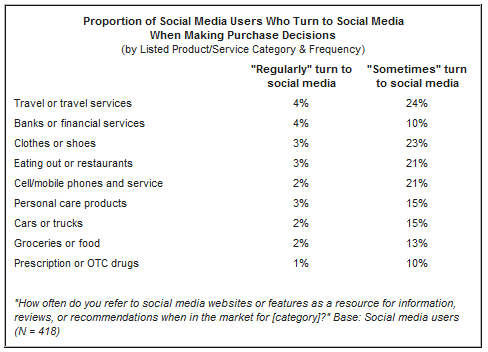Report says, social networks not used for purchase decisions
 Social networks ‘rule’ our days. Nevertheless, their monetization outlooks may be hit by some news, I came across yesterday. A recent study by Knowledge Networks reveals that only 5% of users enter social networks for guidance on purchase decisions in any of nine product/service categories.
Social networks ‘rule’ our days. Nevertheless, their monetization outlooks may be hit by some news, I came across yesterday. A recent study by Knowledge Networks reveals that only 5% of users enter social networks for guidance on purchase decisions in any of nine product/service categories.
Everybody is talking about ways for companies to promote their services, products and brands. It seems that companies cannot exist anymore if they don’t integrate social media tools (Twitter, Facebook, MySpace, etc.) into their web strategy. And seeing the results of the study this seems to make sense. It shows that 83% of all internet users between 13-45 use social networks (47% regularly).
However, only 5% of the respondents say they are influenced in their purchasing decisions and seek guidance from social networks. Also, only 16% are more likely to purchase products from companies that advertise on social networking sites.
“Our findings show that marketers need to be prudent and people-centric in how they approach social media,” said David Tice, vice president and group account director, Knowledge Networks. “Social media users do not have a strong association between these sites and purchase decisions; they see them as being more about personal connection – so finding ways to embrace that powerful function is key. The fact that they are using social media more now than a year ago is a strong indicator that the influence of these sites and features is here to stay.”
Spot On!
The private aspect and the main intention of “staying connected” with friends and family is still the most important feature of social media. When people log in social networks it seems as if they switch to an atmosphere of privacy – and they don’t want intensive ads to interfere with peer interaction. Although the majority of users believe that ads on social networking sites are a “fair price to pay” in return to use the services for free.
People on social networks need to understand that operating a social network costs money and is not altruism business – and social networks operator should make this clear to their target group. Maybe the social networks should give people the option to either pay for access or accept ads, right from the registration process (or group together like the Social Globe). This might be a way to stop the ‘cost free web’ atmosphere…
PS.
Companies, to my experience, know that it makes definitely sense engaging in social networks. Nevertheless, there is still not enough knowledge and expertise on why, how and in which way to use social networks. Finding the right web strategy and the appropriate approach on how many and which social network activity makes sense, becomes the biggest challenge for them in the future. Rethinking their marketing, PR and sales processes is a must have to make way for an integration of social media into their company strategy. And Dell has proven that social networks are used for purchase decisions…






